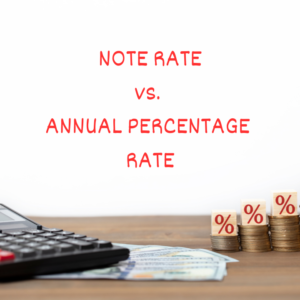Note Rate versus Annual Percentage Rate … NOT the Bait & Switch that Borrowers May Think!
In the quest for ecstatic customers, it’s important to understand how, even if you thoroughly resolve a problematic situation, the experience continues to linger on and influence. Why not, therefore, do everything possible to avoid the problematic situation in the first place?
The annual percentage rate (APR) is not the interest rate at which the borrower’s payment is calculated. The APR represents the cost of originating the loan, expressed as an interest rate. It’s most effectively used for comparative shopping purposes. If one lender offers a particular mortgage with one corresponding APR and another lender offers the exact same mortgage with the only difference being that the other lender’s loan carries a lower APR, what that tells the borrower is that the lender offering the loan with the lower APR is charging lower settlement fees. It absolutely is not the rate at which the borrower’s payment is calculated.
To manifest happy and trusting customers, it is imperative to anticipate and adequately address this issue prior to the consumer receiving the Loan Estimate (LE). Simply assuring your customer that the APR is not the rate at which their payment will be calculated is grossly insufficient. Afterall, why should they believe you? Or, even if they do believe you, wouldn’t you prefer that your customers thoroughly understand the process versus simply taking your word for it? Trust needs to be earned. The way to effectively explain the differing rates to a customer is relatively simple. And, by taking this extra step, you’re one step closer to establishing that well-coveted trust.
Before issuing the disclosures, begin by explaining that the federal government requires lenders to disclose a loan’s annual percentage rate to all mortgage customers for comparative shopping purposes. The APR is simply the cost of originating the loan expressed as an interest rate and NOT the rate at which the customer’s payment is calculated. Because the government wants to make it easy for customers to comparatively shop various lenders, continue by showing how it requires all lenders to disclose the interest rate associated with the sum total of the standard interest to be incurred at the agreed-upon interest rate plus certain settlement costs associated with originating the loan that are incorporated into the financing and not paid by the borrower out of pocket prior to or at the closing table. By the way, “certain costs” refers to settlement fees that would only apply in the presence of a mortgage and not through a cash sale along with third-party fees incurred through particular third-party settlement service providers, the use of which is required by the lender.
Now at this point, your customer’s eyes will most likely be crossed! Assure him or her that you will explain. To ensure their understanding in addition to their knowledge, elaborate by offering them the following example.
Prepare and show the consumer an amortization schedule describing a loan amount of $200,000 at a 6.0% fixed interest rate, for 30 years. Point out how, in assuming that the borrower satisfies the loan through 360 monthly payments (30 years), he or she would ultimately spend the original $200,000 principal balance along with an additional $231,676 in interest for a grand total of $431,676. Next, exemplify the APR’s significance by using an estimated settlement cost expense of $5,000. Then, to ensure their understanding, ask the customer to identify the variable that would have to change in order for the borrower to spend the sum total of the original principal balance plus the normal interest expenditure at 6% plus the $5,000 in settlement costs for a grand total of $436,676 assuming that there were no closing costs built into the loan.
Since the original loan amount and original loan term did not and could not change, the customer should logically conclude that the only variable that could cause a greater overall expenditure would be a higher interest rate. Voila! THAT is the purpose of the APR. Deductively, therefore, if two identical loan options explored through two different lenders disclosed two different APRs, it would be accurate to argue that the lender offering the loan with the higher APR was charging higher settlement fees. And that is how the consumer uses the APR to comparatively shop. It has nothing to do with the rate at which the loan’s payment is calculated.
Not only do you now have a customer who knows that the interest rate to which he or she agreed was the rate that you delivered, he or she also understands that that’s the case. And customers who understand are far more likely to return and refer others to you.


